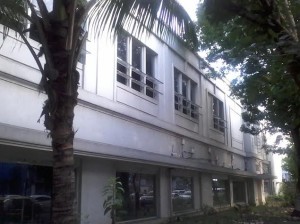
HERITAGE conservation advocates have condemned the demolition of the postwar Coca-Cola plant on Otis Street (now Mendoza Guazon) in Paco, Manila.
Built in 1948, the structure is over 50 years old, making it a presumed important cultural property under the National Heritage Act.
A large part of it has already been demolished, with the façade still intact. The demolition permit was issued by the Manila City government on May 6.
“We are aghast that someone would even consider demolishing [the plant],” said the Heritage Conservation Society through its president, Ivan Henares.
“Unfortunately it is no longer owned by Coca-Cola. I hope the new owners do the right thing,” he added.
But Henares said he was making a public appeal to the new owner to stop the demolition and “repurpose the fantastic plant and integrate it with your new development.”
“Adaptive reuse is a global trend. Please, be a responsible company and contribute to our nation by conserving that significant heritage building. Let’s do this for our country.”
‘Humanizing touch’
The architectural style of the building cannot be determined, but University of Santo Tomas archivist and cultural-heritage professor Regalado Trota José said it was similar to the industrial plants in the country of the late 19th to the early 20th century, like the old San Miguel Brewery plant.
“Long and elongated, with plenty of windows for ventilation. Entrances are architecturally highlighted with rusticated arches and finials,” explained José.
Its length, he said, allowed it to sport seasonal decorations, such as the belen or Nativity Scene during Christmas.
“This ‘style,’ as with other buildings of the era, gave a humanizing touch to the encroaching assembly-line and later automatic style of industry (as compared to factories now even in techno parks in Alabang and Laguna),” José explained.
Preserve the past
Speaking at the Catholic Bishops’ Conference of the Philippines Biennial Conference in Sorsogon City on June 1 (before this issue came out), National Historical Commission of the Philippines chair Ma. Serena Diokno stressed the importance of heritage preservation, saying there was a legal or moral responsibility attached to heritage.
“The duty of the present generation is to preserve significant traces of the past, tangible and intangible, just as it will be the duty of future generations to preserve heritage created by the generation today,” she said.
“We are all, therefore, stewards of heritage with a view not only to the past but also to the future.”
“If we destroy our heritage or allow it to rot, we will lose a chunk of our past and, with it, ourselves.”
Patrimony
Diokno also explained that private structures did not only belong to the owners but also to the public.
“I maintain that, even when the historic site or structure is privately owned, it belongs to all people, not in a material or legal sense as embodied in the title to the property, but in the manner of the collective or communal mind and spirit enriched by heritage,” she said.
“In this sense, heritage knows no physical border, or, to put it a little more accurately, heritage transcends boundaries of ownership and physical location.”